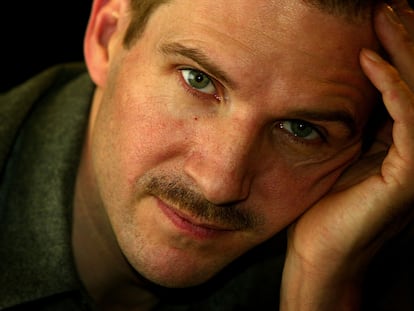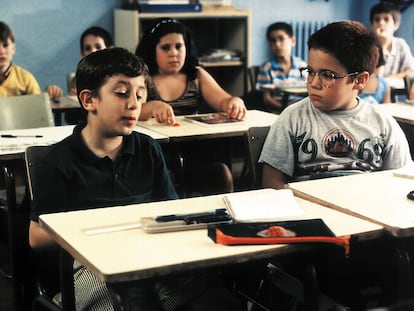An intimate look at Roald Dahl through his letters: funny, irreverent and passionate about the absurd
The book ‘Love from Boy’ compiles the letters that the writer sent to his mother over the course of four decades. He didn’t find out that she had kept them until after her death
Over the course of 40 years, writer Roald Dahl sent more than 600 letters to his mother. From the strict boarding schools of the United Kingdom, on the frontlines of World War II, or while he toured Los Angeles, Texas, Washington and New York as a writer of dazzling fame, he never stopped. From the age of nine until he was 50, Roald always wrote to Mum. And she, Sofie Magdalene, a feisty woman who had been widowed early, with too many children to care for, kept all the letters in a neat pile.
He was nine years old. From St. Peter’s boarding school, he wrote to tell her that he had a great time playing soccer every day and that the beds there didn’t have springs. “Could you send me my stamp albums and a few sheets of stamps?”
At 14 — from the new boarding school in Repton, a village in the county of Derbyshire — he wrote to her jokingly: “It seems like you’re painting a lot… but when you paint the toilet, don’t paint the seat, leaving it wet and sticky, or some unfortunate person will get stuck without realizing it. Unless his butt is amputated, or unless he chooses to go around with the seat stuck to his buttocks, he will be condemned to stay where he is and do nothing but shit for the rest of his life.”
Dahl was 22 and as an oil company employee who traveled the world he wrote to his mother after crossing the Red Sea, informing her about the heavy man by his side, who was somewhat groggy because of the heat. “He’s spread out on his chair like a hot jellyfish and he’s also letting out smoke. He may melt.”
At 25, he was beginning to publish short stories. From the United States, he transmitted the following to her: “I’ve given four speeches in ten days. The average number of attendees — who put on poker faces and open their eyes like cods — ranges between 300 and 400 people, almost always at a dinner. Before I start, I get a little drunk, which makes things a lot easier.”
He was 26 and told her that his landlord in Washington had just kicked him out of his apartment and that the real estate agent had suggested he move to a house where a murder had occurred the previous week. “A man shot a girl in the living room and then blew his brains out. He needed two shots to kill the girl and another two to kill himself, from which I deduced that he didn’t have much aim. Anyway, they told me that the house is now clean and I will move in tomorrow… I don’t have any problem [with this].”
He was 29 and, from the hospital where he had just had an inflamed appendix removed, he wrote to his mom to say that he was finally getting out of there, that he couldn’t take it anymore. “In my room, there are two old men — one has a hernia and the other a boil — and they spend the day farting. They get enemas and talk nonsense and then they fart a few times without hiding or flinching… as if they were saying ‘good morning.’”
And, at the bottom of the letter, he ends — as always — with this: “Love from boy.”
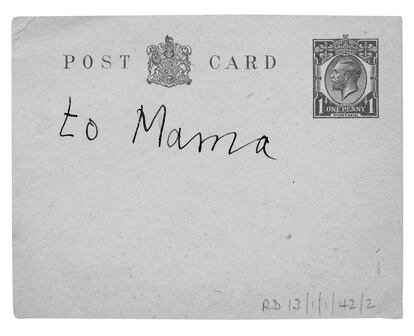
The master of children’s literature — author of classics such as Charlie and the Chocolate Factory or Matilda — can be seen from the intimacy of these letters, in the collection titled Love from Boy: Roald Dahl’s Letters to His Mother (2016). Through the correspondence, the reader sees how a joking, irreverent type of character emerges, a man who is clearly passionate about the absurd. Sometimes, he comes off as grotesque, like in one letter written five days before the outbreak of World War II from Tanganyika, a colonial territory run by the British in East Africa, which is part of Tanzania today. He told his mother about the costume ball the night before: Dahl was wearing white pants tucked into mosquito boots, a black vest inside-out, a ruffled stiff collar, a tweed jacket and an umbrella. “I woke up in the living room at eight in the morning, dressed in my [clergyman’s] costume and still a little damaged, but I’m fine now… if we leave Hitler aside.”
But he couldn’t leave the Führer aside. Three months later, he was writing to mum, telling her about how he had enlisted as a Royal Air Force (RAF) fighter pilot and was going to join the Middle East Command. “I don’t know what you think of all this, but in my opinion, it’s quite exciting… much more [enticing] than enlisting in the Army and marching in the heat from one place to another without doing anything useful. Plus, here, learning to fly is free,” he wrote.
His emotions varied in the correspondence. He first crashed his Gloster Gladiator while flying over the Libyan desert in the dark, not far from the Italian front, suffering serious head injuries and spending seven weeks face-up in a hospital bed. After recovering, he flew again. In a telegram from Alexandria, he informed her: “I feel well. War in Syria is fun.” This was classic Dahl.
The selection of these unpublished letters — as well as the comments, photographs, drawings, maps and comments that accompany them — was carried out by Dahl’s biographer, Donald Sturrock. In conversation with EL PAÍS, Sturrock explains that “these letters show the freshness of spirit and sense of fun possessed by a writer who, even as an old man, continued to see the world as a child sees it. A geriatric child, as he used to say. Dahl was proud of [this character trait]. And, [in this collection], his childish spirit emerges in its most moving form: the letters of a child to his mother.”
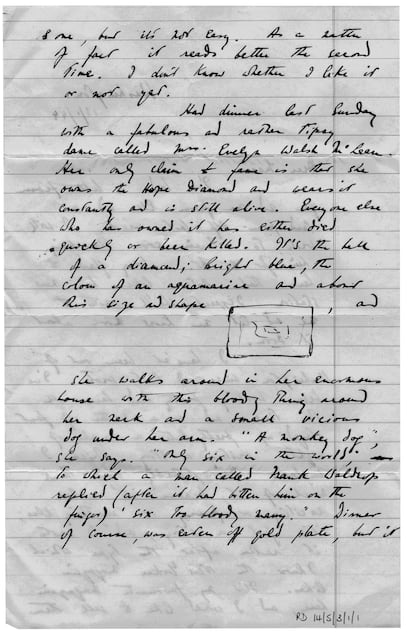
Sturrock emphasizes how the characteristics of Dahl’s literature already appear in these letters: his vocation to entertain, his total lack of inhibition, his taste for the crazy, his eye for extravagant details, his curiosity, his sense of adventure, an innate feeling of subversion, a delight in the strange… and his burning conviction that many adults are absurd.
Humor, Sturrock notes, is perhaps the main quality that unites these letters. “Roald has an eye for everything, whether it’s Repton’s eccentric teachers, [his dog’s] adventures in Africa, putting crayfish in another child’s bed, or making up new words just for fun. Even when times were tough — at boarding school, or at war — he was eager to find something fun to entertain his mother at home and reassure her that her son was okay,” the biographer adds.
In those letters, like a good son, he always hid his problems from his mother, such as the torment he suffered at boarding school, or the loneliness that little Roald felt there, as he would later recount in his book Boy: Tales of Childhood (1984). But what Dahl didn’t know is that his mother was also hiding something from him.
Sofie Dahl kept all those letters, from the very first one, in neat packages tied with green ribbon. She never confessed to her son that she did it. In 1967, Dahl wrote, “when she knew she was dying, I was in hospital, in Oxford, having a serious operation on my spine and I was unable to write to her, so she had a telephone specially installed beside my bed in order that she might have one last conversation with me. She didn’t tell me she was dying nor did anyone else for that matter because I was in a fairly serious condition myself at the time. She simply asked me how I was and hoped I would get better soon and sent me her love. I had no idea she would die the next day but she knew all right and she wanted to speak to me for one last time. When I recovered and went home, I was given this vast collection of my letters…” These were the first letters of a great writer.
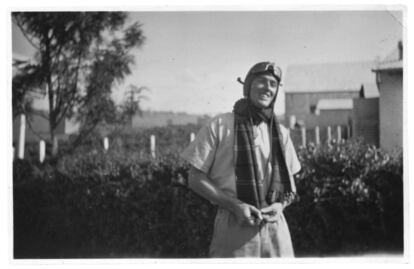
Today, amidst the rereading that dominates classic children’s literature — even with the attempts to censor and rewrite Dahl’s stories, which forced Penguin Random House to rectify its intention to remove references to “fat people,” “ugly people,” “crazy people,” or the violent episodes that are sprinkled in his stories — Dahl’s work emerges as subversive among political correctness.
“As his work ages,” Sturrock maintains, “it continues to be disturbing and uncomfortable, especially for many adults. His belief that children should think for themselves and his delight in subverting both authority and expectations remain controversial. His books celebrate resilience and triumph over adversity. They celebrate individuality and non-conformity. They’re also almost completely lacking in [narcissism]. In this time of social media, I wonder if doctors shouldn’t prescribe them as a kind of psychological medicine… a survival manual for children!”
And what about adults? Well, this is the last sentence that Roald Dahl wrote in his last book: “Those who don’t believe in magic will never find it.”
Sign up for our weekly newsletter to get more English-language news coverage from EL PAÍS USA Edition
Tu suscripción se está usando en otro dispositivo
¿Quieres añadir otro usuario a tu suscripción?
Si continúas leyendo en este dispositivo, no se podrá leer en el otro.
FlechaTu suscripción se está usando en otro dispositivo y solo puedes acceder a EL PAÍS desde un dispositivo a la vez.
Si quieres compartir tu cuenta, cambia tu suscripción a la modalidad Premium, así podrás añadir otro usuario. Cada uno accederá con su propia cuenta de email, lo que os permitirá personalizar vuestra experiencia en EL PAÍS.
¿Tienes una suscripción de empresa? Accede aquí para contratar más cuentas.
En el caso de no saber quién está usando tu cuenta, te recomendamos cambiar tu contraseña aquí.
Si decides continuar compartiendo tu cuenta, este mensaje se mostrará en tu dispositivo y en el de la otra persona que está usando tu cuenta de forma indefinida, afectando a tu experiencia de lectura. Puedes consultar aquí los términos y condiciones de la suscripción digital.
More information
Archived In
Últimas noticias
Most viewed
- Oona Chaplin: ‘I told James Cameron that I was living in a treehouse and starting a permaculture project with a friend’
- Sinaloa Cartel war is taking its toll on Los Chapitos
- Reinhard Genzel, Nobel laureate in physics: ‘One-minute videos will never give you the truth’
- Why the price of coffee has skyrocketed: from Brazilian plantations to specialty coffee houses
- Silver prices are going crazy: This is what’s fueling the rally

